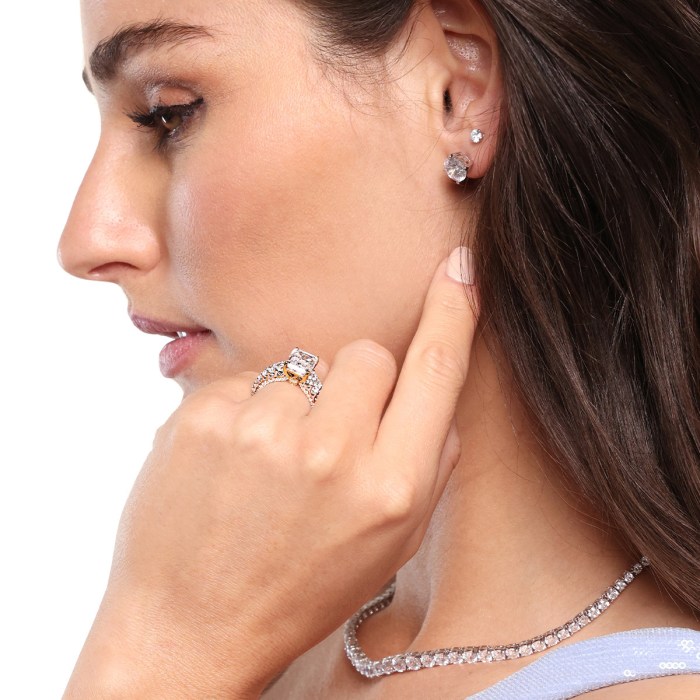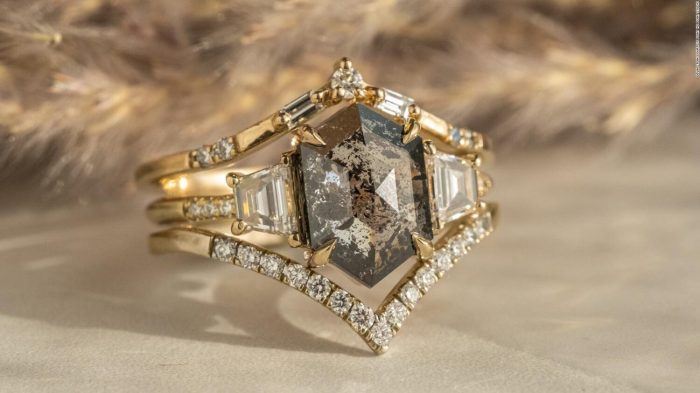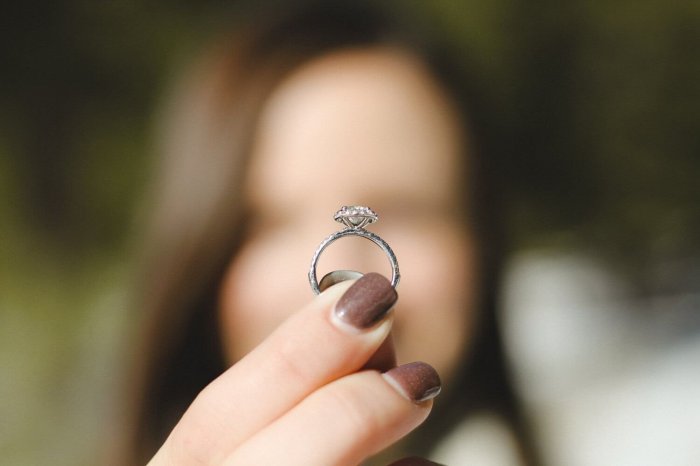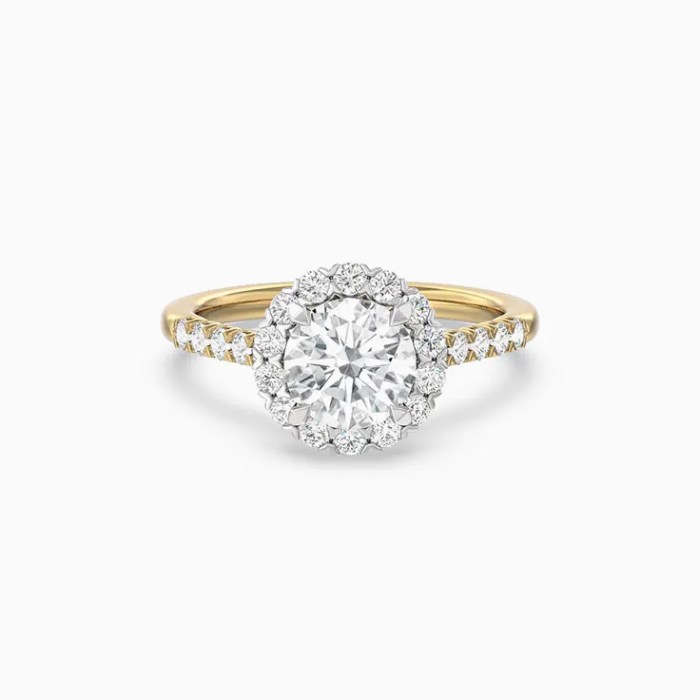Best lab grown diamonds engagement rings are quickly becoming the go-to choice for couples seeking a blend of beauty, ethics, and value. As more people learn about the process of creating these stunning stones, the advantages over traditional mined diamonds are becoming increasingly clear. Not only do lab grown diamonds offer a more environmentally friendly option, but they also provide exceptional quality at a fraction of the cost.
With a variety of styles and customization options available, lab grown diamond engagement rings cater to every taste and preference. The quality grading of these diamonds is on par with natural ones, ensuring that you find a perfect ring that sparkles just as brightly. Whether you’re looking for a classic solitaire or a modern halo design, there’s a lab grown diamond engagement ring that’s just right for you.
Overview of Lab Grown Diamonds

Source: allw.mn
Lab grown diamonds are a modern marvel, created using advanced technology that replicates the natural processes formed deep within the Earth. Unlike their mined counterparts, which can take billions of years to form, lab grown diamonds can be produced in a matter of weeks. This innovative approach not only satisfies the demand for beautiful diamonds but also addresses various ethical and environmental concerns associated with traditional diamond mining.The creation of lab grown diamonds primarily involves two methods: High Pressure High Temperature (HPHT) and Chemical Vapor Deposition (CVD).
In the HPHT method, carbon is subjected to intense pressure and high temperatures, mimicking the natural conditions under which diamonds develop. Meanwhile, the CVD process involves the use of carbon-containing gases, which are ionized to form a plasma, allowing carbon atoms to gradually deposit and crystallize into diamond over time. Both techniques result in diamonds that are chemically, physically, and optically identical to mined diamonds, ensuring the same brilliance and durability.
Benefits of Choosing Lab Grown Diamonds
Selecting lab grown diamonds offers numerous advantages that are appealing to modern consumers. These benefits include:
- Cost-Effectiveness: Lab grown diamonds are typically 20-40% less expensive than natural diamonds, allowing buyers to invest in larger or higher-quality stones within the same budget.
- Ethical Sourcing: As lab grown diamonds are manufactured in controlled environments, they eliminate concerns related to conflict diamonds and unethical mining practices, providing peace of mind to consumers.
- Customization: Many retailers offer customizable options for lab grown diamonds, enabling buyers to select specific cut, carat, color, and clarity features that suit their personal preferences.
- Quality Assurance: Lab grown diamonds are graded using the same criteria as natural diamonds, ensuring consistent quality and reliability in their characteristics.
Environmental Impacts of Lab Grown Diamonds
The environmental footprint of lab grown diamonds is significantly smaller compared to that of mined diamonds. The conventional diamond mining process often results in extensive land disruption, habitat destruction, and considerable water usage, alongside contributing to pollution and carbon emissions. In contrast, the production of lab grown diamonds:
- Lower Land Disruption: Lab grown diamonds require no mining, preserving natural ecosystems and reducing the need for significant land alteration.
- Reduced Carbon Emissions: The energy consumption for producing lab grown diamonds can be minimized through the use of renewable energy sources, leading to lower overall carbon emissions.
- Water Conservation: Mining operations typically consume vast amounts of water, while lab grown diamond production utilizes significantly less water, contributing to better resource management.
- Waste Management: The controlled environment of lab grown diamond production allows for better management of waste and byproducts, minimizing environmental pollution.
Lab grown diamonds present an ethical and environmentally friendly alternative, proving that luxury and sustainability can coexist.
Features of Engagement Rings with Lab Grown Diamonds

Source: vergecampus.com
Engagement rings featuring lab grown diamonds have gained immense popularity in recent years, offering couples a stunning alternative to traditional diamonds. With the same beauty and brilliance as natural diamonds, these rings showcase innovative designs and ethical considerations that resonate with modern consumers. Understanding the features of these rings helps couples make informed choices while selecting the perfect symbol of love.Lab grown diamonds can be found in a variety of styles, allowing couples to express their unique personalities and preferences.
Some of the most popular styles include classic solitaire settings, halo designs that amplify the diamond’s sparkle, and vintage-inspired rings that evoke timeless charm. Additionally, modern designs often incorporate intricate band details or mixed materials, such as gold and platinum, to enhance the overall aesthetic.
Quality Grading of Lab Grown Diamonds
The quality of lab grown diamonds is assessed using the same grading criteria as natural diamonds, known as the four Cs: cut, color, clarity, and carat weight. Each of these factors plays a crucial role in determining the diamond’s overall appearance and value.
- Cut: The cut of a diamond influences its brilliance and sparkle. Lab grown diamonds are cut to maximize their light performance, often achieving ideal or excellent cut grades.
- Color: Lab grown diamonds come in a range of colors, from colorless to shades of yellow or brown. The color grading scale ranges from D (colorless) to Z (light yellow), with higher grades being more desirable.
- Clarity: Clarity refers to the presence of internal or external flaws, known as inclusions and blemishes. Lab grown diamonds can achieve clarity grades similar to those of natural diamonds, with many being classified as eye-clean.
- Carat Weight: Carat weight measures the size of the diamond. Lab grown diamonds are available in various carat weights, allowing couples to choose a size that fits their style and budget.
Price Comparison between Lab Grown and Traditional Diamonds
One of the most significant advantages of lab grown diamonds is their cost-effectiveness. Generally, lab grown diamonds are priced 20% to 40% lower than their natural counterparts. This price difference is largely attributed to the controlled production process of lab grown diamonds, which eliminates many of the costs associated with mining.For example, a one-carat lab grown diamond might retail for approximately $2,500, while a similar quality natural diamond could cost around $4,000 to $5,000.
This price disparity allows couples to invest in larger stones or opt for higher quality diamonds without exceeding their budget. The financial benefits, combined with the ethical considerations of lab grown diamonds, make them an appealing choice for discerning couples.
Choosing the Right Lab Grown Diamond Engagement Ring: Best Lab Grown Diamonds Engagement Rings

Source: squarespace-cdn.com
Selecting the perfect lab grown diamond engagement ring involves understanding several key aspects that ensure your choice reflects the personality and preferences of your partner. By considering the elements that contribute to the beauty and value of lab grown diamonds, you can make an informed decision that symbolizes your love and commitment.The 4Cs—Cut, Color, Clarity, and Carat—are the fundamental characteristics that define the quality of a diamond.
Each of these aspects plays a crucial role in determining the overall appearance and value of lab grown diamonds, making them essential for your selection process.
Understanding the 4Cs of Lab Grown Diamonds
The 4Cs are instrumental in assessing the quality and beauty of lab grown diamonds. Each of these characteristics provides insight into the diamond’s value and aesthetic appeal.
- Cut: The cut of a diamond influences its brilliance and sparkle. A well-cut diamond reflects light beautifully, creating a stunning display. The cut is often considered the most important of the 4Cs, as it directly affects the diamond’s overall appearance.
- Color: Lab grown diamonds are available in a range of colors, with D being completely colorless and Z indicating noticeable color. For engagement rings, diamonds in the G-H range are popular as they provide a balance between quality and affordability while appearing near-colorless.
- Clarity: Clarity refers to the presence of inclusions or blemishes in a diamond. The fewer imperfections a diamond has, the higher its clarity grade, which enhances its beauty. For engagement rings, diamonds with a clarity rating of VS1-VS2 are often preferred, as they offer an excellent balance of clarity and value.
- Carat: Carat weight measures the size of the diamond. Larger carat weights are usually associated with higher values, but it’s essential to balance size with the other 3Cs for an overall appealing choice.
Choosing the Right Setting for the Engagement Ring, Best lab grown diamonds engagement rings
The setting of an engagement ring is just as important as the diamond itself, as it influences the ring’s overall style and how the diamond is showcased. An ideal setting will complement the diamond while reflecting the wearer’s personal style.When selecting a setting, consider the following factors:
- Style: Engagement ring settings come in various styles, such as solitaire, halo, three-stone, and vintage. Choose a style that aligns with your partner’s taste and lifestyle.
- Material: The metal used for the band can significantly affect the overall look of the ring. Popular choices include white gold, yellow gold, rose gold, and platinum. Each metal has its unique characteristics and appeal.
- Durability: The ring’s durability is crucial, especially for everyday wear. Platinum is known for its strength, while gold bands can also be durable with proper care.
- Gemstone Accents: Some settings incorporate additional gemstones, such as side stones or colored diamonds, to enhance the overall design. This can add a personal touch that resonates with your partner’s style.
“Choosing the right setting not only showcases the diamond but also reflects the individuality of the wearer.”
Trends in Lab Grown Diamond Engagement Rings

Source: cloudinary.net
Lab grown diamonds have rapidly gained popularity in the realm of engagement rings, merging modern technology with timeless love stories. As couples increasingly opt for ethical and budget-friendly alternatives to mined diamonds, the trends surrounding lab grown diamond engagement rings are continually evolving, reflecting both personal style and environmental consciousness. One significant trend is the emphasis on unique shapes and settings that reflect individuality.
Couples are moving beyond traditional round cuts and exploring various fancy shapes like emerald, oval, and pear to make their engagement rings distinctive. Additionally, the settings are becoming more innovative, with designs featuring intricate metalwork and mixed materials that enhance the brilliance of lab grown diamonds.
Customization Options Available for Lab Grown Diamond Rings
Customization is a key element in the lab grown diamond market, allowing couples to create pieces that resonate with their personal styles and stories. The customization process typically involves selecting the diamond’s carat weight, cut, color, and clarity, which gives couples a hands-on approach to crafting their perfect ring. Many jewelers also provide options for ring settings, including classic solitaires, halo designs, and more modern, asymmetrical settings.
Couples can choose metals ranging from traditional platinum and white gold to contemporary rose gold and yellow gold, enhancing the overall aesthetic of the ring. The ability to engrave personal messages or dates inside the band adds a sentimental touch that further personalizes the piece.To illustrate the customization landscape, here are some popular choices couples are making:
- Diamond Shape: Round, princess, oval, cushion, pear, and emerald cuts are among the most sought-after shapes.
- Metal Type: Options include platinum, white gold, yellow gold, rose gold, and even alternative metals like titanium or stainless steel.
- Setting Styles: Classic solitaire, pavé, halo, vintage-inspired, and bespoke designs that match personal aesthetics.
- Engravings: Personalized engravings with names, initials, or significant dates.
Popular Jewelry Designers Specialized in Lab Grown Diamond Engagement Rings
As the market for lab grown diamonds expands, numerous jewelry designers have emerged, focusing on creating exquisite engagement rings that feature these ethically-sourced stones. Some renowned designers have become favorites for their innovative designs and commitment to sustainability. These designers often incorporate unique artistic visions into their work, making each piece a representation of the couple’s love story. Here is a list of some popular jewelry designers specializing in lab grown diamond engagement rings:
- Brilliance: Known for its wide selection of lab grown diamonds and customizable settings, Brilliance offers a range of styles for every taste.
- Clean Origin: This designer emphasizes ethically sourced diamonds and provides a variety of trendy designs with transparent pricing.
- James Allen: Offers an extensive collection of lab grown diamonds and allows customers to create custom rings with a user-friendly online platform.
- Verragio: Renowned for its intricate settings and detailed craftsmanship, Verragio has expanded its offerings to include stunning lab grown diamonds.
- Lily Arkwright: Specializes in bespoke engagement rings with lab grown diamonds, focusing on sustainability and unique designs.
Summary

Source: doozydiamonds.com
In summary, best lab grown diamonds engagement rings not only represent a commitment to love but also to sustainable and ethical practices. As you explore the various styles, trends, and features of these exquisite rings, remember that choosing a lab grown diamond is a step towards a more responsible future in jewelry. With their beauty, affordability, and environmental benefits, these rings make a striking statement about your values and love.
Question & Answer Hub
What are lab grown diamonds made of?
Lab grown diamonds are made of carbon atoms arranged in the same crystal structure as natural diamonds, resulting in identical physical and chemical properties.
How do lab grown diamonds compare in value to natural diamonds?
Lab grown diamonds typically cost 20-40% less than natural diamonds, offering a more budget-friendly option without sacrificing quality.
Are lab grown diamonds more sustainable?
Yes, lab grown diamonds have a significantly lower environmental impact compared to mined diamonds, as they require less land disruption and use fewer resources.
Can you customize a lab grown diamond engagement ring?
Absolutely! Many jewelers offer customization options for lab grown diamond engagement rings, allowing you to select the setting, style, and diamond characteristics that best fit your vision.
Do lab grown diamonds hold their value?
While lab grown diamonds may not appreciate in value like natural diamonds, they retain their worth and can be resold, especially if they’re certified.